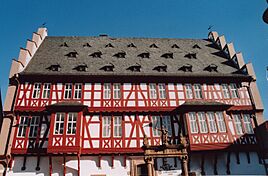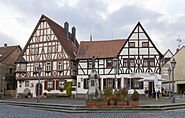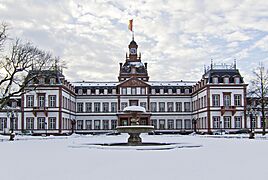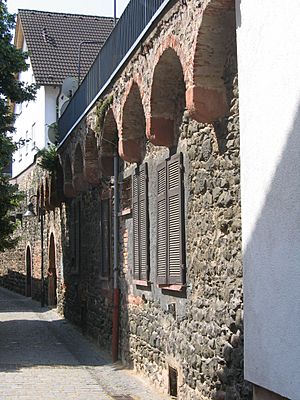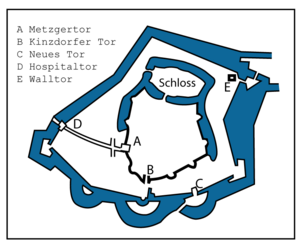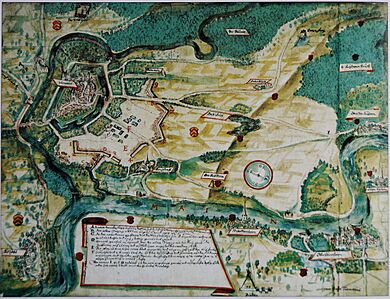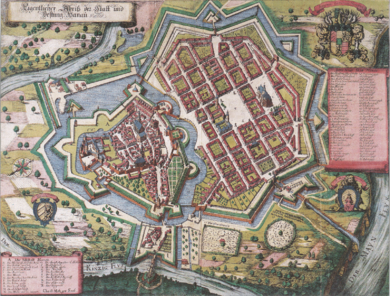Hanau facts for kids
Quick facts for kids
Hanau
|
|||
|---|---|---|---|
|
Goldsmiths' House (Hanau old town hall)
Hanau-Steinheim old town
Schloss Steinheim
Schloss Philippsruhe
|
|||
|
|||
| Country | Germany | ||
| State | Hesse | ||
| Admin. region | Darmstadt | ||
| District | Main-Kinzig-Kreis | ||
| Elevation | 104 m (341 ft) | ||
| Population
(2022-12-31)
|
|||
| • Total | 101,364 | ||
| Time zone | CET/CEST (UTC+1/+2) | ||
| Postal codes |
63450, 63452, 63454 63456, 63457
|
||
| Dialling codes | 06181 | ||
| Vehicle registration | HU | ||
| Website | www.hanau.de | ||
Hanau is a city in Hesse, Germany. It's located about 25 kilometers (15 miles) east of Frankfurt. Hanau is an important place for travel and trade because it has a big railway station and a port on the Main River.
The city is famous for being the birthplace of the Brothers Grimm, who collected many well-known fairy tales. Since the 1500s, Hanau has also been a center for working with precious metals, especially for goldsmiths. Today, it's home to Heraeus, one of Germany's largest family-owned companies.
Hanau was once the main city for the Counts of Hanau. Sadly, many of its beautiful old buildings were destroyed during World War II. A British air raid in 1945 caused a huge fire, destroying most of the old city. However, some outer parts of Hanau still have charming old timber-framed towns like Hanau-Steinheim and castles like Schloss Philippsruhe.
In 1963, Hanau hosted the Hessentag, a big state festival.
Contents
Where is Hanau?
The oldest part of Hanau is located inside a curve of the Kinzig River. This river flows into the Main River just west of the city. Over time, Hanau grew a lot, especially in the 1800s and 1900s. In the 1970s, some nearby villages and towns became part of Hanau. This expansion meant that Hanau now also reaches the south bank of the Main River.
What is Hanau's Weather Like?
Hanau has a climate with warm summers. The weather here is similar to what you might find in Eastern Germany. It gets cold enough for snow in winter, especially in January and February. Summers are warm, with July and August being the hottest months.
| Climate data for Hanau | |||||||||||||
|---|---|---|---|---|---|---|---|---|---|---|---|---|---|
| Month | Jan | Feb | Mar | Apr | May | Jun | Jul | Aug | Sep | Oct | Nov | Dec | Year |
| Record high °C (°F) | 13 (55) |
18 (64) |
26 (79) |
30 (86) |
33 (91) |
35 (95) |
36 (97) |
36 (97) |
31 (88) |
27 (81) |
20 (68) |
16 (61) |
36 (97) |
| Mean daily maximum °C (°F) | 3 (37) |
5 (41) |
10 (50) |
14 (57) |
19 (66) |
22 (72) |
24 (75) |
24 (75) |
19 (66) |
14 (57) |
8 (46) |
4 (39) |
14 (57) |
| Mean daily minimum °C (°F) | −2 (28) |
−1 (30) |
2 (36) |
4 (39) |
8 (46) |
11 (52) |
13 (55) |
12 (54) |
9 (48) |
5 (41) |
2 (36) |
−2 (28) |
5 (41) |
| Record low °C (°F) | −20 (−4) |
— | −12 (10) |
−5 (23) |
— | 3 (37) |
4 (39) |
2 (36) |
1 (34) |
−2 (28) |
−9 (16) |
— | −20 (−4) |
| Average precipitation mm (inches) | 30 (1.2) |
30 (1.2) |
30 (1.2) |
40 (1.6) |
50 (2.0) |
70 (2.8) |
50 (2.0) |
50 (2.0) |
50 (2.0) |
30 (1.2) |
50 (2.0) |
50 (2.0) |
530 (21.2) |
| Average snowfall cm (inches) | 9 (3.5) |
10 (3.9) |
4 (1.6) |
trace | 0 (0) |
0 (0) |
0 (0) |
0 (0) |
0 (0) |
0 (0) |
6 (2.4) |
10 (3.9) |
46 (18) |
| Average rainy days | 10 | 8 | 8 | 9 | 10 | 10 | 10 | 10 | 8 | 8 | 10 | 10 | 111 |
| Average snowy days | 4 | 3 | 1 | 1 | 0 | 0 | 0 | 0 | 0 | 0 | 1 | 3 | 13 |
| Average relative humidity (%) | 89 | 84 | 85 | 82 | 80 | 80 | 81 | 84 | 89 | 91 | 89 | 90 | 85 |
| Mean daily sunshine hours | 1 | 3 | 4 | 6 | 7 | 7 | 7 | 6 | 5 | 3 | 1 | 1 | 4 |
| Source: WeatherBase and Fremdenverkehrsbuero.info (temperature, rainy and sunny days) | |||||||||||||
Hanau's Neighborhoods
Hanau is divided into several districts, each with its own character:
- Innenstadt (city center)
- Nordwest (northwest) including Wilhelmsbad
- Südost (southeast)
- Lamboy
- Steinheim
- Klein-Auheim (Hanau)
- Großauheim
- Wolfgang
- Kesselstadt
- Mittelbuchen
What Does the Name Hanau Mean?
The name "Hanau" comes from an older word, Hagenowe. This word combines Haag, which means 'wood' (like a small forest), and Aue, which means 'open land by a river'. So, Hanau's name means something like "wooded land by the river."
A Look at Hanau's Past
The Old Town's Story
Hanau was first mentioned in records in 1143. It started as a castle that used the Kinzig River for defense. A noble family, who called themselves "of Hanau," owned this castle from the 1200s. A village grew around the castle and became a town in 1303.
At first, Hanau's main church was outside its walls in a village called Kinzdorf. Over time, the people from Kinzdorf moved into the town, and the village became empty, leaving only the church. Later, in the 1400s, the church inside Hanau's walls, St. Mary's Church, became the main church.
In the early 1300s, the first town walls were built. But Hanau quickly grew too big for them. A new settlement formed outside the walls along the road to Frankfurt. This area was later included when Hanau built new, modern Renaissance-style fortifications in the early 1500s. These new walls protected the old castle, the medieval town, and the new settlement.
The New Town's Beginning
Welcoming Huguenots to Hanau
In 1597, Count Philipp Ludwig II invited French Protestant refugees, called Huguenots, to settle in Hanau. These refugees had faced difficulties in Frankfurt. The Count hoped that bringing these skilled people from southwest France would help Hanau's economy and culture grow.
The Huguenots were promised freedom to practice their religion. In return, they agreed to help Hanau's economy. This is why Hanau is still known for its goldsmiths today. Hanau also had Germany's first workshop to make faïence, a type of glazed pottery. These new citizens had their own rules, church, and government for the "new town of Hanau" (Neustadt Hanau), separate from the old town.
Other Refugees and Jewish Community
Hanau also welcomed Walloon and Dutch Calvinist refugees from areas that are now the Netherlands and Belgium. Their arrival, along with the Huguenots, helped Hanau become an important business center. The new town remained separate from the old town until 1821. The Walloon-Dutch community still exists today.
Count Philipp Ludwig II also allowed Jewish people to settle in Hanau. A Jewish community was re-established in 1604.
It took over 200 years for the old and new towns to officially join. The new town, which was larger, had strong Baroque-style defenses. These defenses helped the town survive a siege during the Thirty Years' War in 1637 with little damage. The new citizens became very important to the economy and politics of the County of Hanau.
Hanau in the 1600s and 1700s
During the Thirty Years' War, Hanau was taken by the Swedes in 1631. In 1636, it was attacked by imperial troops. However, on June 13, William V, Landgrave of Hesse-Kassel helped the city. Hanau still celebrates this day.
In 1736, Johann Reinhard III of Hanau-Lichtenberg, the last Count of Hanau, passed away. His lands, including Hanau, were inherited by the Landgraviate of Hesse-Kassel. For a while, Hanau became the capital of its own state, Hesse-Hanau, until 1786. Even after that, it was the second most important town in Hesse-Kassel, after Kassel.
Hanau in the 1800s
During the Napoleonic Wars, Emperor Napoleon ordered Hanau's defenses to be torn down. This allowed the old and new parts of the town to grow and connect. In 1813, the Battle of Hanau happened near the city, where Napoleon's French troops won against Austro-Bavarian forces. In the 1820s, the governments of both Hanau towns merged. The first common Mayor was Bernhard Eberhard.
Hanau became a center for heavy industrialisation in the 1800s. Companies like Heraeus and Degussa grew here. This growth was helped by Hanau becoming a major railway hub with six railway lines:
- 1848: Frankfurt-Hanau Railway
- 1854: Main–Spessart Railway
- 1867: Frankfurt–Bebra Railway, eastern direction
- 1873: Frankfurt–Bebra Railway, western direction
- 1879/1881: Friedberg–Hanau Railway
- 1882: Odenwald Railway
Hanau and the 1848 Revolution
In 1848, Hanau was a key place for the German democratic movement. It played an important role in the Revolution of 1848. The German Gymnastic League (Deutscher Turnerbund) was also founded here in 1848. In 1866, Hanau became part of Prussia after the Austro-Prussian War. It remained part of Prussia until 1945.
By the late 1800s, Hanau was a big military town. Many military railway engineers and other units were stationed there because of its important railway connections. Hanau also became known for its silver manufacturing industry during this time.
Hanau in the 1900s
During World War II, the Jewish population in Hanau faced persecution. The last Jewish residents were deported in May 1942.
The inner city of Hanau was mostly destroyed by British air raids in March 1945, just days before the U.S. Army arrived. About 87% of the town was ruined. Of the 15,000 people still in the city, 2,500 died in the attack.
Hanau was home to one of the largest U.S. Army bases in Europe. At its peak during the Cold War, about 45,000 military members and their families lived there. The base included Hanau Army Airfield. The U.S. garrison closed in April 2018. Many of the former military areas are now used for civilian purposes.
Hanau in the 2000s
In 2010, Hanau began a huge project to rebuild and redesign its inner city. These are the biggest construction works in the town since it was rebuilt after World War II. In September 2021, Hanau reached a population of 100,000 people.
Hanau's Economy
Many people in Hanau work for the technology company Heraeus. Others travel to Frankfurt for work. Frankfurt International Airport is only 30 kilometers (18 miles) away.
Hanau's Population
- Hanau has a population of 101,364, making it the sixth largest town in Hesse.
- More than 20% of the people living in Hanau are from other countries, with many being Turkish workers.
| Largest groups of foreign residents | |
| Nationality | Population (2011) |
|---|---|
| 8,010 | |
| 1,917 | |
| 943 | |
| 647 | |
| 560 | |
| 560 | |
Hanau's Jewish Community
The first records of Jewish people in Hanau date back to 1313. In the 1600s and 1700s, Hanau became an important place for printing Hebrew books. In 1925, there were 568 Jewish people living in Hanau.
Hanau's Sister Cities
Hanau has special connections with other cities around the world, called twin towns or sister cities:
 Conflans-Sainte-Honorine, France
Conflans-Sainte-Honorine, France Dartford, United Kingdom
Dartford, United Kingdom Francheville, France
Francheville, France Nilüfer, Turkey
Nilüfer, Turkey Taizhou, China
Taizhou, China Tottori, Japan
Tottori, Japan Yaroslavl, Russia
Yaroslavl, Russia
Friendly Cities
Hanau also has friendly relationships with:
Getting Around Hanau
Train Travel in Hanau
Hanau is a major transportation center in Germany, especially for trains. Its main station connects to many important railway lines:
- Frankfurt-Hanau Railway (RE / RB 55)
- Main-Spessart-Bahn (from Hanau to Aschaffenburg Hauptbahnhof) (RE / RB 55)
- Kinzig Valley Railway to Fulda (RE / RB 50)
- Frankfurt-Bebraer railway (westbound) to Offenbach Hauptbahnhof, Frankfurt am Main Hauptbahnhof, and the S-Bahn
- Friedberg-Hanau railway (RB 33)
- Odenwaldbahn (RE / RB 64) towards Babenhausen, Groß-Umstadt-Wiebelsbach, Erbach, and Eberbach
Besides the main station, other train stops in Hanau include Hanau West, Hanau-Wilhelmsbad, Großauheim, Wolfgang an der Kinzigtalbahn, Steinheim (Main) S-Bahn station, Hanau Nord, and Hanau-Klein Auheim.
Places to See in Hanau
- Deutsches Goldschmiedehaus: A place dedicated to the art of goldsmithing.
- Schloss Philippsruhe: A beautiful castle.
- Wilhelmsbad: A historic spa (a place for health and relaxation).
- Marienkirche (Hanau) (St Mary's Church): An important church in the city.
- Wallonisch-Niederländische Kirche: A church with a unique history tied to the refugees who settled in Hanau.
-
Lion at Schloss Philippsruhe by Christian Daniel Rauch
Famous People from Hanau
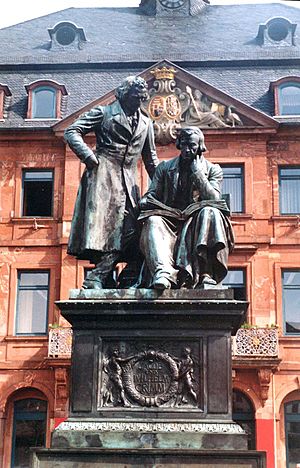
Many notable people were born or lived in Hanau:
- Louis Appia (1818–1898): A surgeon who helped start the International Committee of the Red Cross.
- Johann Christian Claudius Devaranne (1784–1813): A leader against Napoleon.
- Siegmund Feniger: A Buddhist monk.
- Jürgen Grasmück (1940–2007): An author of horror and science fiction stories.
- The Brothers Grimm (Brüder Grimm): Jakob and Wilhelm were born here. They collected many German fairy tales and began working on a German dictionary.
- Ludwig Emil Grimm (1790–1863): A painter and the younger brother of Jakob and Wilhelm Grimm.
- Solomon Hanau (1687–1746): A master of the Hebrew language.
- Hans Daniel Hassenpflug (1794–1862): A German statesman.
- Paul Hindemith (1895–1963): A famous composer.
- Alois Kottmann (1929–2021): A violinist born in Großauheim.
- Johann Peter Krafft (1780–1856): A painter.
- Daniel la Rosa (born 1985): A racing driver.
- Moritz Daniel Oppenheim (1800–1882): A painter, often seen as the first modern Jewish painter.
- Bodo Sperling (born 1952): A German painter and artist.
- Karl Storck (1826–1887): A Romanian sculptor.
- Hermann Volk (1903–1988): A Roman Catholic bishop.
- Rudi Völler (born 1960): A football (soccer) world champion in 1990 and later coach of the German national team.
- Wilhelm Wagenfeld (1900–1990): A well-known designer.
Sports in Hanau
Hanau has several historic sports clubs:
- Turngemeinde 1837 Hanau a.V. (TGH): One of Germany's oldest sports clubs.
- Hanauer Rudergesellschaft 1879 e.V. (HRG): One of Germany's oldest rowing clubs.
- Hanau 93 (1. Hanauer Fußball Club 1893 e.V. or HFC): Hesse's oldest association football (soccer) club.
See also
 In Spanish: Hanau para niños
In Spanish: Hanau para niños


